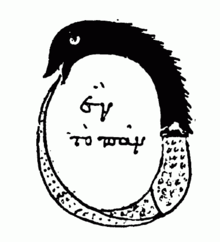Chrysopoeia

In alchemy, the term chrysopoeia (Ancient Greek: χρυσοποιία, khrusopoiia) means transmutation into gold (from the Greek χρυσός, khrusos, "gold", and ποιεῖν, poiein, "to make"). It symbolically indicates the creation of the philosopher's stone and the completion of the Great Work.
The word was used in the title of a brief alchemical work, the Chrysopoeia of Cleopatra, which was written in the first centuries of the Christian era, but which is first found on a single leaf in a tenth-to-eleventh century manuscript in the Biblioteca Marciana, Venice, MS Marciana gr. Z. 299.[1] The document features an ouroboros containing the words "The All is One" (ἕν τὸ πᾶν, hen to pān), a concept that is related to Hermeticism. Stephen of Alexandria wrote a De Chrysopoeia.[2] Chrysopoeia is also the title of a 1515 poem by Giovanni Augurello.
See also
References